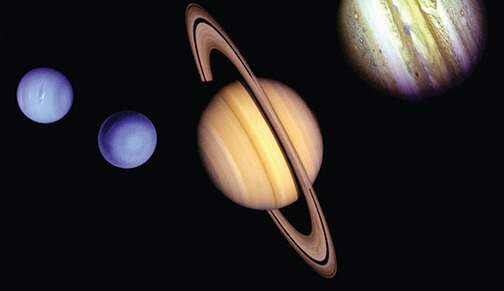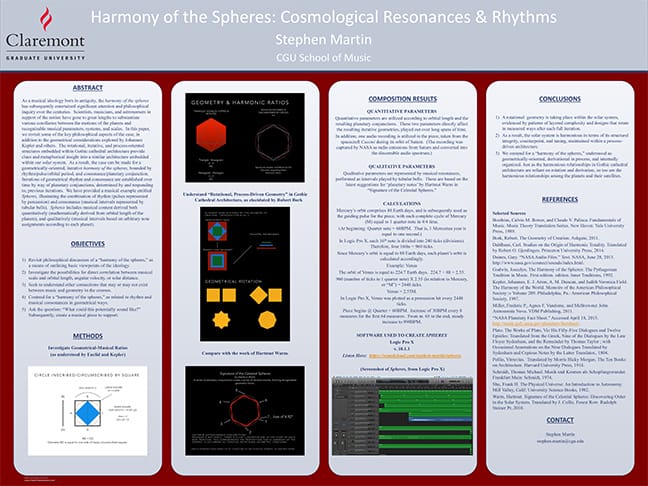Student Stephen Martin Explores “Cosmic Music”

Late seventeenth-century astronomer Johannes Kepler gazed out into the solar system and saw harmony in the motions of the planets.
Stephen Martin studied this harmony and put it to music.

Exploring connections between the musical arts and mathematical sciences, the CGU doctoral student in CGU Music Department created a composition, Spheres, based on an analysis and interpretation of orbital data.
Martin’s “Harmony of the Spheres: Cosmological Rhythm & Resonance” was the winning transdisciplinary studies project for the 2015 Commencement Forum Competition. Martin’s work is an exploration of a medieval philosophical concept known as musica mundana (“music of the spheres”), an idea that regards the regular, proportional movements of the Sun, the Moon, and the planets as a form of “cosmic music.”
For Spheres, he plotted how celestial movements corresponded with certain geometrical figures and relationships over time. The timing of percussion instruments and musical intervals were, in part, derived from orbital alignments or instances when planets reached their farthest (aphelion) and nearest (perihelion) points—“decisive moments,” Martin called them—from the Sun.
“When you start to hear this play out over time, it seems there is this gigantic dance going on,” said Martin, a professor of music at Azusa Pacific University and its director of music and worship. “I enjoy thinking about this concept of the planets dancing out there, and we are a part of that dance here on Earth.”
While others have studied the mathematics of the planets, Martin focused on how they corresponded with geometrical relationships.
“I debated on whether or not to take on the project because it was putting together two or three subjects—if not more,” he said. “I wanted to make sure that I was bringing them together in some sort of meaningful way.”
While he relied on authoritative NASA data, Martin also made some subjective decisions, such as assigning Mercury’s orbit of 88 Earth days to the value of one quarter note (60 beats per minute) in 4/4 time.
“The piece speeds up over time, lending to the feeling that the planets are taking part in a cosmic dance over the course of centuries and millennia,” he added.
Martin used instrumental software for Taiko and bodhrán drums, and chimes, as well as Logic Pro X, a digital audio workstation for composing. He also utilized an audio recording of emissions from Saturn taken from the spacecraft Cassini in orbit as an audio loop.

Martin has been fascinated by astronomy since he was young. Spheres drew upon the ideas of Kepler and other medieval astronomers, but also the work of Robert Bork, an art history professor who has written extensively about how the shape and design of Gothic cathedrals are tied to geometric relationships. Martin also based his project on the writings of Hartmut Warm, a German engineer who wrote Signature of the Celestial Spheres and created computer renderings of the complex patterns behind the solar system’s structure.
To listen to Spheres, go to https://soundcloud.com/stephen-martin/spheres.